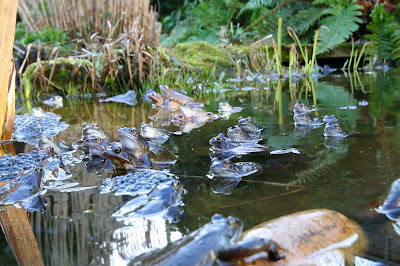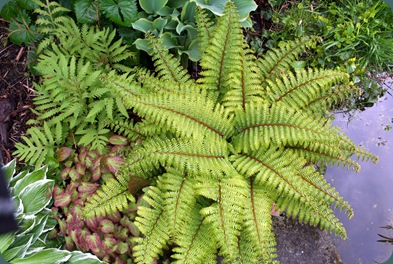
Above: Polystichum polyblepharum (right) and Onoclea sensibilis (left)
It’s been cold and windy for the last few days and looks set to continue like this through the weekend. So far, there is not much sign of new growth in the ferns except for the Tree Ferns where I can feel the coiled fronds amongst the dried leaves etc. that currently fill the funnel at the top of the trunk. The old leaves and old fronds help protect this new growth from frosts.
I grow about 30 different types of ferns and collecting more species and varieties is quite addictive. I even have a collection of books on the subject including some Victorian books written in the heyday of fern collecting mania.
Mostly I grow ferns in the more shady areas of the garden but some species do well and even require
sunnier sites. They mix very well with Hostas and with any large leafed plants including Colocasias where they add to an exotic effect.
Generally the cultivation of ferns is very very easy providing one knows which ones prefer shade, which prefer damp ground and which prefer dry. Tree ferns require a little more attention particularly in keeping their trunks moist during the summer months.
Having learnt my lesson from omitting to keep a record of all the Hosta varieties I have, I’ve gone in the opposite direction and keep a database of all the ferns including their position in the garden. Recording the position of ferns is not really needed for the evergreen varieties but recording the position of the deciduous ones helps to keep me from accidentally digging them up.
Another reason for recording their names is that most have ridiculously long and difficult names to remember (I think this may be part of their appeal!). And another reason for recording their names and position is that so many look exactly like each other despite being different species etc. There is something about ‘collecting’ which is enjoyable despite the fact that so much of the collection looks the same. I used to collect bus numbers as a child!
Amongst the collection there are some beautiful ferns and particular favourites. Polystichum polyblepharum (Tassel Fern) shown in the photo at the top of this post is one such, the way the fronds ‘fan out’ from the centre of the plant is very attractive. In future posts I will highlight some of my other favourites.
The following is an excerpt from my database and I’d welcome any comments or suggestions for new acquisitions:
| Dryopteris | affinis ‘Polydactyla Dadds’ | Behind pear tree |
| Cheilanthes | lanosa | On bank next to Box |
| Dryopteris | filix-mas (male fern) | Near fence by Fatsia |
| Matteuccia | struthiopteris (Shuttlecock Fern) | By pond / fence |
| Athyrium | niponicum ‘Pictum’ | In front of bamboo by Cordyline |
| Blechnum | penna-marina | Under Cordyline |
| Dropteris | erythrorora | Between Cordyline and bamboo |
| Osmunda | regalis ‘Purpurascens’ | Bottom bed front of Poplar |
| Polypodium | ?? | Corner of pond (house,fence) |
| Polystichum | proliferum | Right of Fatsia by bed edge. |
| Asplenium | trichomanes, (Maidenhair Spleenwort) x 2 | Under sleeper near bench and near Gunnera |
| Adiantum | venustum, (Himalayan Maidenhair) | Front of pear tree & under tree fern |
| Polystichum | polyblepharum, (Tassel Fern) | Far side of pond, head of path |
| Asplenium | ?? crested | Next pond |
| Asplenium | ?? | In wall crevices |
| Athyrium | otophorum ‘Okanum’ | Behind tree fern & in front of bamboo by pond |
| Polystichum | tsussimense | Right of tree fern |
| Athyrium | ‘Ghost’ | Between black bamboo and tree fern |
| Dryopteris | affinis, ‘Cristata the King’ | Behind black bamboo |
| Dryopteris | buschiana, (aka crassirhizoma) | Front right of ? bush |
| Onoclea | sensibilis | Near pond path, next P.Polyblepharum |
| Dryopteris | wallichiana | Front of ? bush |
| Athyrium | filix-femina ‘Frizelliae’ (tatting) | Right of Fatsia in front of D. filix-mas |
| Polystichum | setiferum ‘Plumodensum’ | |
| Gymnocarpium | dryopteris ‘Plumosum’ | Between Fatsia and end of bed. |
| Athyrium | filix-femina var. angustatum ‘Lady in Red’ | Behind Cordyline |
| Dicksonia | Antarctica x 2 | Can’t miss them! |
| Polystichum | setiferum, ‘Dahlem’ | By fence but presumed dead. Signs of life 27/5/07. Seems OK 4/6/07 |
| Polypodium | vulgare | |
| Adiantum | pedatum, ‘Japonicum’ | Missing presumed lost |
| Cyrtomium | fortunei var. clivicola | Died (by Fatsia) |
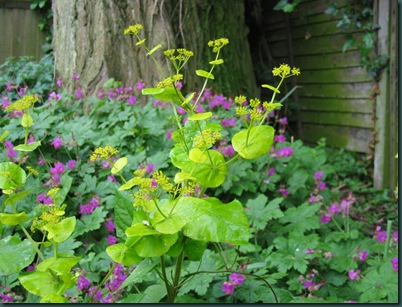
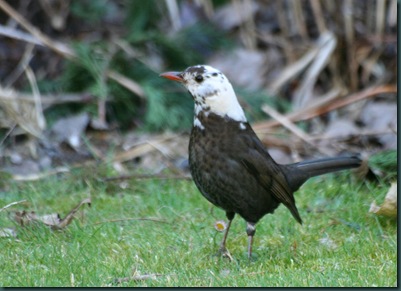


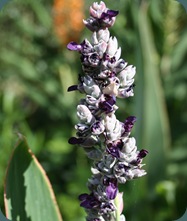
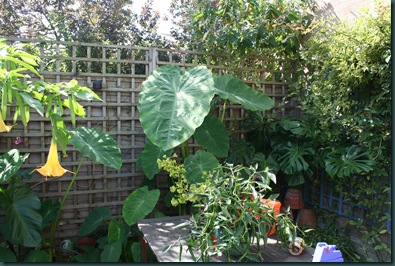
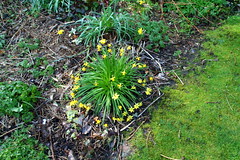
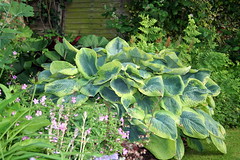
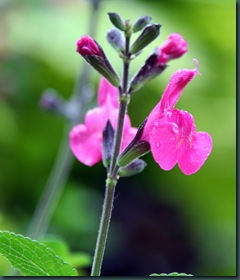
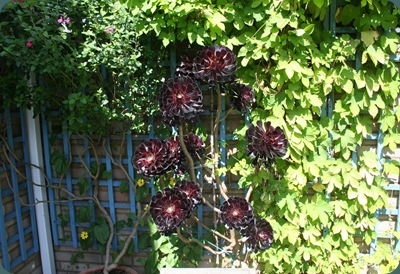


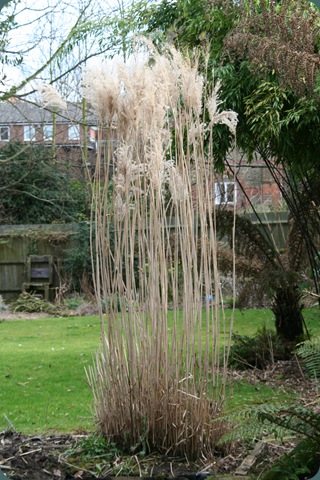
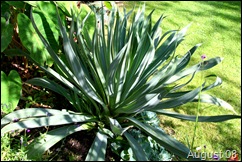 Another of my favourite plants and one that adds an exotic effect to the garden. As the name implies this plant has a resemblance to Yuccas and looks ‘spiky’ but it is actually very soft and hence can safely be grown next to a path. It grows a neat rosette of gray / green fleshy leaves up to about 3ft tall.
Another of my favourite plants and one that adds an exotic effect to the garden. As the name implies this plant has a resemblance to Yuccas and looks ‘spiky’ but it is actually very soft and hence can safely be grown next to a path. It grows a neat rosette of gray / green fleshy leaves up to about 3ft tall.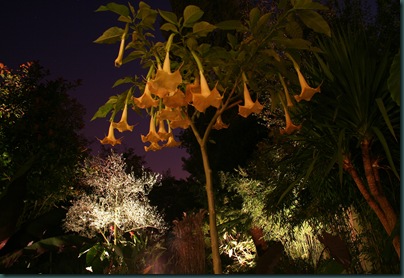 Brugmansia at night
Brugmansia at night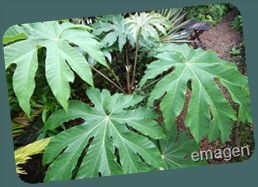 Tetrapanax papyrifera ‘Rex’ – What a name and what a plant!
Tetrapanax papyrifera ‘Rex’ – What a name and what a plant! 
